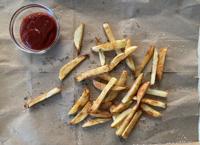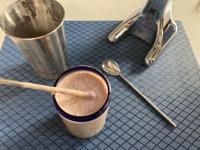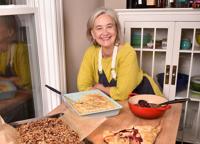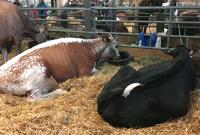When the weather is cold, it’s always nice to arrive home to the welcoming aroma of a delicious meal. Using a slow cooker to heat food over a long period of time allows it to be ready right at dinner time.
Although January has often been regarded as “slow cooker month,” this common countertop appliance can be used all year long to prepare terrific meals.
The slow cooker was invented and patented in 1940 by a gentleman named Irving Nachumsohn (also called Naxon). After the rights to the slow cooker were purchased by Rival Manufacturing, the device was renamed to the vernacular Crock-Pot and rose in popularity in the 1970s.
Slow cookers use less electricity than an oven, and, unlike an oven, they will not heat up your house in the summer months. The appliance is appreciated by many because it can allow for one-step preparation and cleanup, and may be used to cook a variety of foods, ranging from main courses to side dishes and even desserts. Slow cookers also offer the benefit of tenderizing less-expensive cuts of meat, providing savings for what is often the most expensive part of a meal.

Before diving in to enjoy all the benefits of using a slow cooker, it’s important to understand the proper guidelines to ensure the appliance is being used correctly to avoid food poisoning or foodborne illness; also, like with any other household appliance, it is important to follow the manufacturer’s recipes, directions, and safety guidelines. Slow cookers work by heating food in the wide range of 170 F to 280 F for long periods of time, so be sure to read through the device’s instruction manual to understand the specifics of each model. Most slow cookers have 2 or 3 cooking settings:
• Low setting cooks food for 6 to 10 hours.
• High setting cooks food for 4 to 6 hours.
• The warm setting is not for cooking food. It is used to keep already cooked food hot.

Stay at home during the cooker’s first use to make sure it is not malfunctioning. Test for proper operation beforehand by heating 2 quarts of water in the covered cooker on low for eight hours, periodically checking the water’s temperature with a calibrated food thermometer to make sure it is maintaining 185 F.
Always start food preparation with a clean cooker, as well as clean hands, utensils and surfaces. The key to preparing food correctly and safely in a slow cooker is to ensure that the device is on the proper temperature setting for the proper amount of time with the proper amount of liquid to create steam.

Safety tips from the U.S. Department of Agriculture Food Safety Inspection Service include:
• Do not cook frozen meat or poultry in a slow cooker, as a slow cooker can take several hours to reach a high enough temperature to destroy bacteria. If food stays in the temperature danger zone (between 40 F and 140 F) for too long, food poisoning can result.

• Always thaw and brown meat prior to placing it into a slow cooker, as this step will add to the meat’s color and flavor and may even reduce its fat content.
• Preheat the cooker with a hot liquid when cooking meat and poultry.
• Cut meat into large chunks for even heating.
• Unless a recipe advises differently, set the slow cooker on high for the first hour to ensure a rapid heat up, then turn the heat setting to low.
• Minimize the number of times the lid is removed, as this causes the temperature to drop 10 to 15 F, thus elongating the cooking time by 20 to 30 minutes. Remove the lid only to stir or check the food for doneness.
• Do not overfill the slow cooker —it should be 1/2 to 2/3 full of food.
• Vegetables cook the slowest in slow cookers, so place them on the bottom and sides of the cooker, which puts them closest to the heating unit of the device.
• Always rehydrate items like dried beans before placing them into a slow cooker.
• Food should be removed from the cooker to cool down.
• Add pasta, herbs, spices, fish and seafood late in the cooking process. Pasta, fish and seafood do not need a long time to cook, so add them later in the cooking process; and herbs and spices can lose their flavor or turn bitter if cooked too long.
![5 questions for Phyllis Good about her new 5-ingredient cookbook [recipes]](https://bloximages.newyork1.vip.townnews.com/lancasteronline.com/content/tncms/assets/v3/editorial/5/47/54787c98-129c-11eb-a603-b30abd47ba30/5f8e81a49e05a.image.jpg?resize=200%2C248)
• Slow cookers can be used to keep food hot once the food is fully cooked but should not be used to reheat food.
Now that you know important food safety tips for working with a slow cooker, enjoy the convenience and satisfaction that slow cooker meals can provide to your family.
Stacy Reed is an educator with Penn State Extension in Lancaster, specializing in food safety and nutrition.




![Why I'm looking forward to John Lurie's 'Painting with John' on HBO [Unscripted column]](https://bloximages.newyork1.vip.townnews.com/lancasteronline.com/content/tncms/assets/v3/editorial/7/ec/7ec33210-512e-11eb-9202-7f7d16530194/5ff77bf1ecca7.image.jpg?resize=200%2C113)
![Columbia nun's methods sparked academic achievement [I Know a Story column]](https://bloximages.newyork1.vip.townnews.com/lancasteronline.com/content/tncms/assets/v3/editorial/2/22/2228913c-51e5-11eb-82c2-d3f2b7856105/5ff8ae566aa3a.image.jpg?resize=200%2C150)




![Follow these food safety rules when using your slow cooker [Extension column] | Food + Living Follow these food safety rules when using your slow cooker [Extension column] | Food + Living](https://bloximages.newyork1.vip.townnews.com/lancasteronline.com/content/tncms/assets/v3/editorial/5/9a/59ab1fea-5527-11eb-86db-cf66f0252e88/5ffe25cdb8329.image.jpg?crop=280,210,14,0&resize=280,210&order=crop,resize)
/cdn.vox-cdn.com/uploads/chorus_image/image/62810996/Amm_DeepSentinel_01.0.jpg)

More Stories
TheyDo fires the starting gun on the race to own the customer journey • TechCrunch
How To Develop Buyer Personas: A Crash Course
stocks to buy: 2 top stock recommendations from Aditya Agarwala